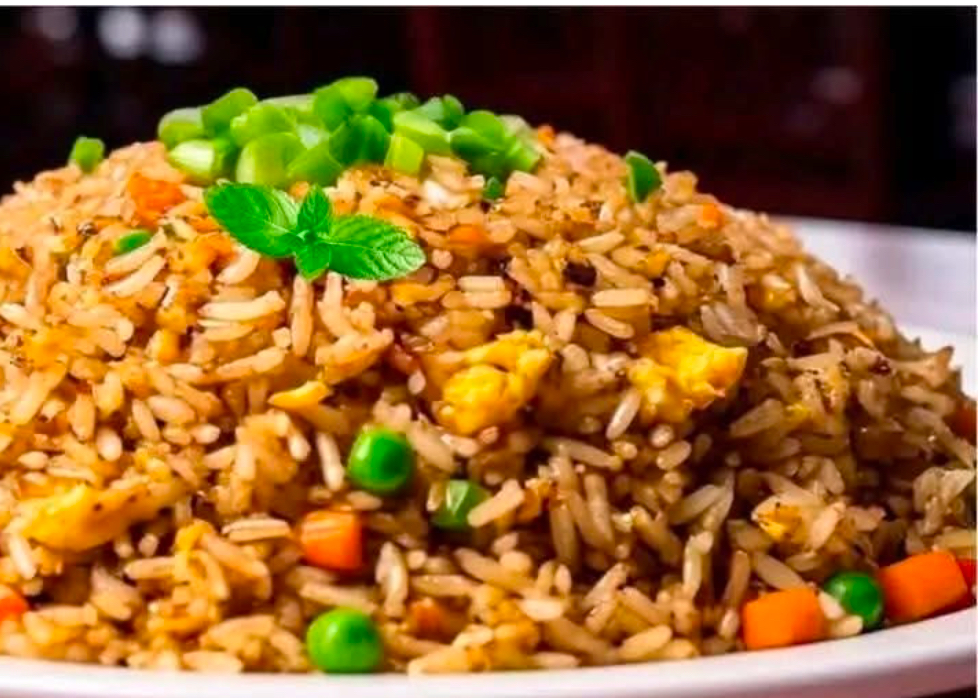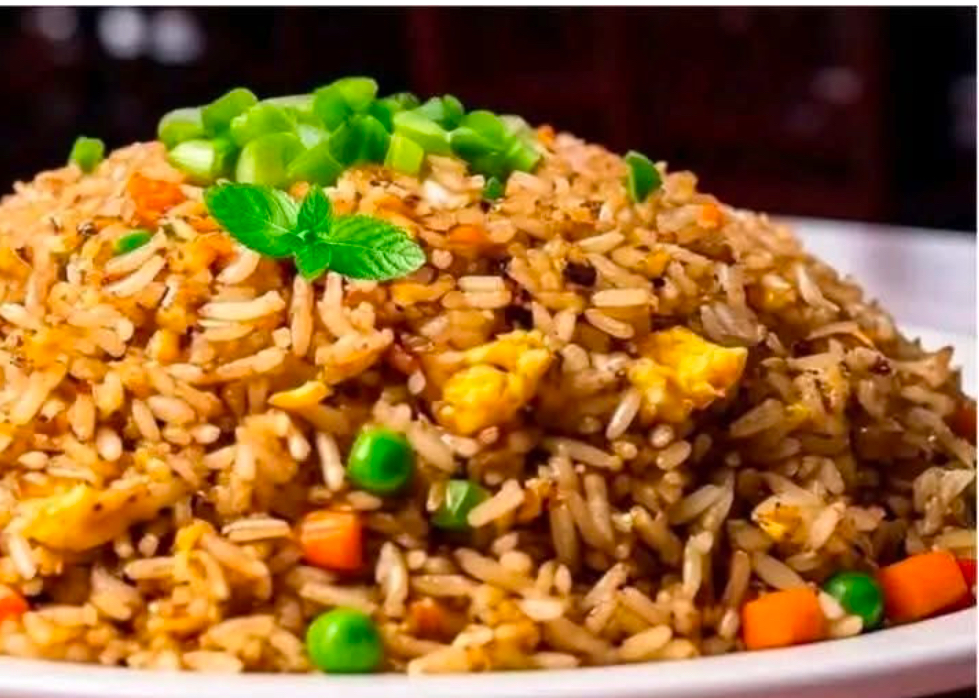
Introduction
Egg Fried Rice is a versatile and beloved dish originating from Asia, particularly China. It’s a perfect way to transform leftover rice into a flavorful and satisfying meal. This dish combines the richness of eggs, the crunch of vegetables, and the umami punch of soy sauce, making it a global favorite. It is quick to prepare, budget-friendly, and highly customizable, making it a go-to comfort food for many.
Ingredients
Main Ingredients:
• 3 cups cooked white rice (preferably day-old for better texture)
• 2 tablespoons vegetable oil (or sesame oil for extra flavor)
• 1½ cups frozen peas and carrots mix
• 1 medium onion, finely chopped
• 1 tablespoon minced garlic
• 2 large eggs, lightly beaten
• 3 tablespoons low-sodium soy sauce (adjust to taste)
Optional Additions:
• 1 tablespoon oyster sauce or hoisin sauce
• 1 teaspoon sesame seeds
• Green onions (chopped for garnish)
• Cooked shrimp, chicken, or tofu for protein
Instructions
Preparation:
1. Prepare Rice: Use leftover rice for better texture. If cooking fresh, let it cool completely or refrigerate for a few hours.
2. Thaw Vegetables: If using frozen vegetables, let them thaw slightly.
3. Beat Eggs: Lightly whisk eggs in a small bowl.
Cooking Process:
1. Heat Oil: Heat 1 tablespoon of oil in a large wok or skillet over medium-high heat.
2. Cook Eggs: Pour in the beaten eggs and scramble until just cooked. Remove and set aside.
3. Sauté Vegetables: Add the remaining oil, garlic, and onions. Sauté for 2–3 minutes until fragrant. Add the peas and carrots and cook for another 2–3 minutes.
4. Add Rice: Increase heat to high and add the cooked rice. Stir-fry for 3–4 minutes, breaking up clumps with a spatula.
5. Season: Pour in soy sauce and mix thoroughly to coat the rice evenly.
6. Combine Ingredients: Return the scrambled eggs to the wok and stir to combine. Cook for 1–2 minutes to ensure all flavors are mixed.
7. Garnish and Serve: Remove from heat, garnish with green onions or sesame seeds, and serve hot.
Methods
1. Stovetop Method: Cook in a wok or skillet as described above.
2. Instant Pot Method: Use the sauté function for each step and switch to “Keep Warm” for a one-pot solution.
3. Baked Version: Toss ingredients on a baking sheet and bake at 375°F (190°C) for 10–15 minutes for a less greasy alternative.
History
Egg Fried Rice dates back to the Sui Dynasty (589–618 AD) in China and was created as a way to reuse leftover rice. Its origins lie in Chinese households where no food was wasted. Over centuries, it became a staple across Asian countries like Japan, Indonesia, and Thailand, each adding its unique spin. Today, it’s a symbol of simplicity and culinary creativity worldwide
Egg Fried Rice, one of the simplest yet most beloved dishes worldwide, has a rich history rooted in Chinese culinary traditions. It is a dish that exemplifies creativity, resourcefulness, and cultural exchange.
Origins in China
• Ancient Beginnings:
Egg Fried Rice is believed to have originated during the Sui Dynasty (589–618 AD) in China. It was created as a way to repurpose leftover rice, ensuring no food went to waste—a core principle of traditional Chinese cooking.
• Cantonese Influence:
The dish is particularly associated with Cantonese cuisine, where rice is a dietary staple. The Cantonese refined the art of fried rice, emphasizing balanced flavors, textures, and the use of fresh ingredients.
Evolution Through Time
• Classic Fried Rice Variations:
Over centuries, Chinese chefs began experimenting by adding eggs, vegetables, and various proteins, creating numerous regional variations. Egg Fried Rice became a base recipe, inspiring countless adaptations like Yangzhou Fried Rice, which includes shrimp, pork, and peas.
• Street Food Staple:
In the early 20th century, Egg Fried Rice transitioned from a home-cooked meal to a popular street food item in China, thanks to its affordability, ease of preparation, and satisfying flavors.
Global Spread
• Trade and Migration:
As Chinese immigrants traveled across Asia, Europe, and the Americas, they brought their culinary traditions with them. Egg Fried Rice became a global favorite, adapting to local tastes and ingredients.
• Adoption in Southeast Asia:
Countries like Thailand, Indonesia, and Malaysia gave the dish their own twist by incorporating local flavors like fish sauce, sambal, or kecap manis (sweet soy sauce). Thai-style fried rice, for example, often includes lime, chili, and basil.
• Western Influence:
In the West, Egg Fried Rice became a popular takeaway dish, especially in Chinese-American restaurants. It evolved into a versatile side dish served alongside stir-fries, sweet-and-sour chicken, and more.
Symbol of Resourcefulness
Egg Fried Rice represents frugality and creativity in Chinese culture. It showcases how leftover ingredients can be transformed into something flavorful and satisfying. The dish’s adaptability made it a staple during times of economic hardship and a favorite among busy households.
Modern-Day Popularity
Today, Egg Fried Rice is celebrated globally as:
• A quick and easy comfort food.
• A foundation for culinary creativity, with countless variations.
• A symbol of Chinese culinary heritage and its influence on world cuisine.
Its timeless appeal lies in its simplicity and ability to adapt to personal tastes, making it a beloved dish across generations and cultures.
Benefits
1. Nutrient-Rich:
• Eggs: Packed with protein, Vitamin D, and healthy fats.
• Vegetables: Provide essential vitamins like A, C, and fiber.
2. Energy-Boosting: The carbohydrates in rice provide lasting energy.
3. Versatile: Adaptable to dietary preferences—add proteins, make it vegetarian, or go gluten-free.
4. Quick to Prepare: Ready in less than 20 minutes, making it ideal for busy lifestyles.
Nutrition (Per Serving)
• Calories: 300–350
• Protein: 10–12g
• Carbohydrates: 40–45g
• Fat: 10–12g
• Fiber: 3–4g
• Sodium: 500–600mg (depends on soy sauce quantity)
Benefits of Egg Fried Rice
Egg Fried Rice is not only delicious but also offers several nutritional and practical benefits. Here’s a detailed look at its advantages:
1. Nutritional Benefits
• Rich in Protein:
Eggs are a great source of high-quality protein, essential for muscle repair, growth, and overall body function. Adding shrimp, chicken, or tofu can further boost protein content.
• Carbohydrate Energy:
The rice provides complex carbohydrates, a primary energy source, ideal for active individuals.
• Vitamins and Minerals:
• Vegetables like carrots, peas, and onions are packed with Vitamin A, C, and antioxidants, supporting immunity and skin health.
• Eggs contribute essential nutrients like Vitamin D, B12, and iron, promoting strong bones and blood health.
• Low in Fat (when made with minimal oil):
Using healthy oils like olive oil or sesame oil keeps the fat content moderate and heart-friendly.
2. Customizable for Dietary Preferences
• Vegetarian/Vegan: Substitute eggs with plant-based proteins like tofu or chickpeas, and it’s a perfect vegan meal.
• Low-Calorie Options: Use brown rice or cauliflower rice to lower calorie intake while retaining fiber.
3. Easy to Digest
• The simple ingredients and balanced macros make Egg Fried Rice easy on the stomach, suitable for all age groups, including children and seniors.
4. Budget-Friendly
• Utilizes leftover rice and basic pantry staples, making it economical and reducing food waste.
5. Quick and Convenient
• Egg Fried Rice is a one-pan meal, ready in 20 minutes or less, making it ideal for busy schedules or unexpected guests.
6. Versatile Meal Option
• Works as a main course or a side dish. Its flavors pair well with a variety of dishes like stir-fried vegetables, dumplings, or grilled proteins.
7. Promotes Resourcefulness
• Repurposing leftover rice minimizes waste and encourages mindful cooking. This aligns with sustainable and environmentally friendly practices.
8. Provides Essential Nutrients for Daily Function
• Fiber: From vegetables, aiding digestion and promoting gut health.
• Amino Acids: From eggs, supporting overall body repair and maintenance.
• Antioxidants: Fighting free radicals and supporting cellular health.
9. Comfort Food
• Egg Fried Rice is a universally loved comfort food. Its warm, flavorful, and familiar taste makes it emotionally satisfying.
Formation
Egg Fried Rice forms when all ingredients are stir-fried together in high heat, creating a cohesive, flavorful dish. The key is the proper balance of texture: fluffy rice, crunchy vegetables, and soft scrambled eggs.
Conclusion
Egg Fried Rice is more than just a dish—it’s a cultural emblem that celebrates resourcefulness and flavor. Its adaptability and global appeal make it a beloved choice for meals of all kinds. Whether served as a main course or a side dish, it’s guaranteed to satisfy.
Lovers of Egg Fried Rice
This dish is adored globally, especially by:
• College students for its simplicity.
• Families as a quick dinner solution.
• Food enthusiasts for its endless customizations.
• Street food lovers, as it’s a staple in Asian cuisine.
Enjoy making and sharing this timeless, delicious recipe!
